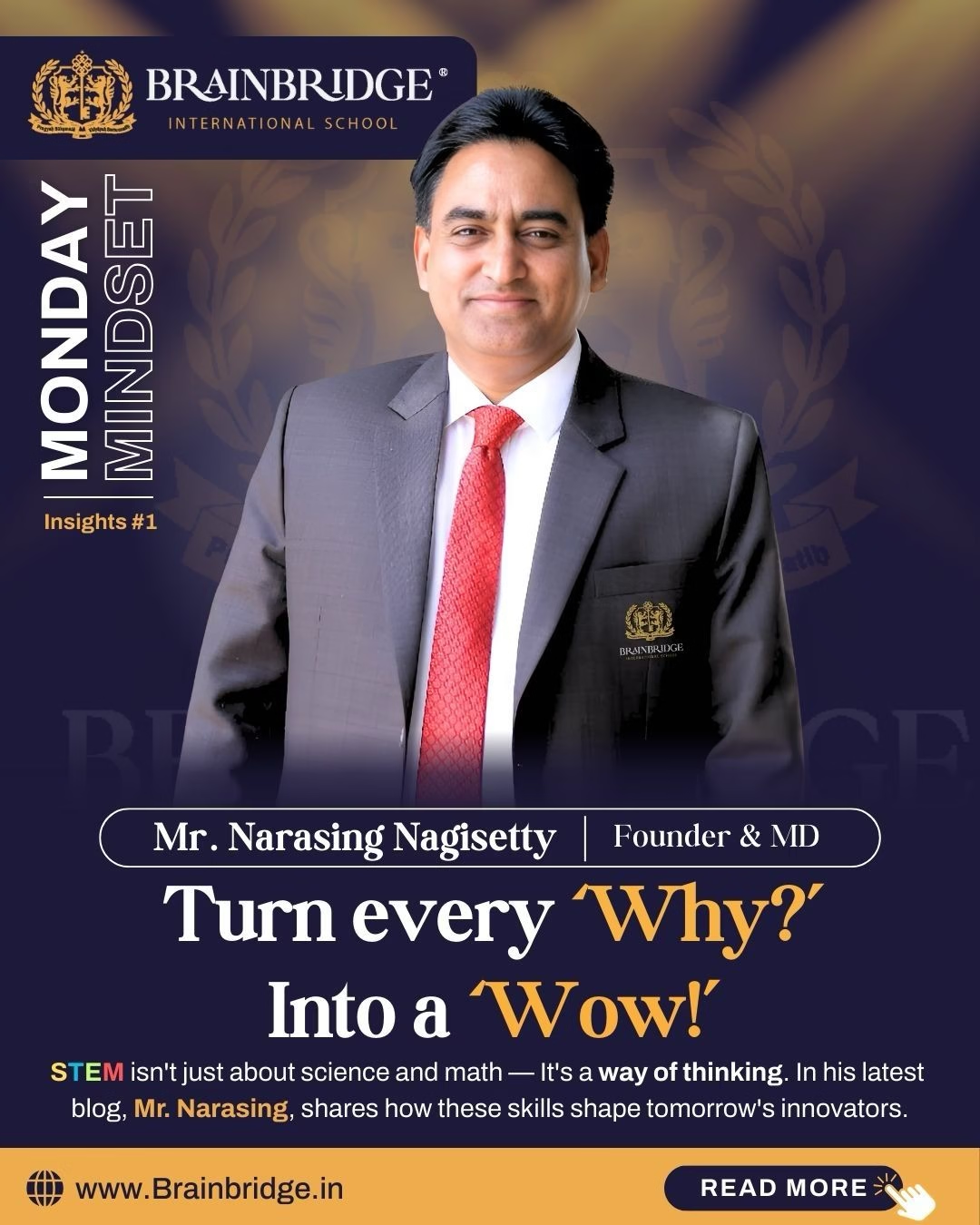Namaste!
Welcome to Brainbridge International School | Where Excellence Meets Innovation.
Welcome to Brainbridge International School | Where Excellence Meets Innovation.

Turning Every ‘Why?ʼ Into a ‘Wow!ʼ By Shri. Narasing Nagisetty, Founder & Managing Director
At Brainbridge International School, I often say: the most powerful words a child can utter are “Why?ˮ and “What if?ˮ.
When my team and I envisioned Brainbridge, we werenʼt imagining classrooms filled with rote memorization or endless tests. We imagined spaces where every question is treated as the spark of something extraordinary. Thatʼs the essence of STEM education, especially when experienced through the IB approach.
STEM is not about equations or definitions. It is about thinking logically, exploring bravely, failing confidently, and trying again creatively. When taught with curiosity at its core, STEM transforms every classroom into a launchpad for ideas that might one day change the world.
As a young boy in Rameswaram, A.P.J. Abdul Kalam was fascinated by flight. That spark of curiosity led him to study aeronautical engineering, work on Indiaʼs first satellite launch vehicle, and earn the title “Missile Man of India.ˮ
His journey is the perfect proof of STEMʼs power — how a single “Why?ˮ can grow into innovations that inspire a nation.
In our classrooms, “Why?ˮ is never an interruption — it is the beginning of discovery.
Curiosity doesnʼt just lead to answers — it creates the drive to keep asking better questions.
When Thomas Edison was a child, he constantly asked questions that often puzzled — and sometimes annoyed — adults. Once, curious about how fire worked, he tried to create one in his fatherʼs barn (which, unfortunately, ended in a small blaze). While not every experiment was a success, that relentless curiosity drove him to hold over 1,000 patents, including the electric light bulb.
Itʼs a reminder that great innovations often start with a simple “Why?ˮ — followed by the courage to explore the answer.
Our students donʼt just solve riddles — they solve problems that matter.
Each challenge connects learning to life, teaching resilience and creativity along the way.
STEM at Brainbridge isnʼt locked in a lab. Itʼs where math, science, art, history, and technology collide.
When subjects collide, creativity explodes — whether that means coding a historical timeline as a video game or testing biodegradable packaging designs in the schoolʼs compost bin.
Indiaʼs Mars Orbiter Mission Mangalyaan) succeeded not because of one brilliant scientist, but because engineers, physicists, mathematicians, coders, and project managers worked in perfect harmony. On a modest budget, India became the first Asian nation to reach Marsʼ orbit — on its first attempt.
I remind our students often: Half the jobs youʼll have in the future donʼt exist yet. They might become:
STEM prepares them for this uncertainty by teaching them how to adapt, think critically, and solve problems that have no back-of-the-book answer. Whether theyʼre curing diseases, building on Mars, or inventing an ice cream that never melts, the core skills remain the same: curiosity, resilience, and creativity.
The best part? Our STEM projects rarely end when the bell rings. Students take ideas home, test them in the kitchen, backyard, or even the neighborhood park. Parents have told us about weekend bridge-building contests in the living room and impromptu debates about solar panels during dinner. Thatʼs when we know STEM has worked — when learning becomes a habit, not just a homework assignment.
For me, STEM is not just about producing scientists or engineers. It is about shaping curious, adaptable, compassionate thinkers who will thrive in any field they choose.
At Brainbridge, every “Why?ˮ becomes a doorway, every “What if?ˮ a stepping stone, and every “Letʼs try!ˮ a leap toward innovation. Just as Abdul Kalamʼs curiosity took him from a boyhood dream to national leadership, I believe the questions of our children today hold the answers to a brighter tomorrow.
I invite you to join us as we turn every “Why?ˮ into a “Wow!ˮ — and shape a generation of thinkers, tinkerers, and trailblazers.
📞 For enquiries, call Toll Free: 1800 889 0111